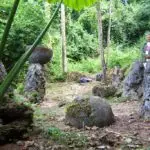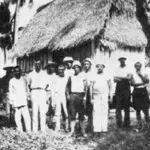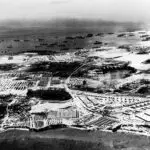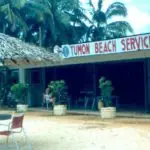The Fight to Keep Tumon Public
Table of Contents
Share This
Attempted military taking of Tomhom (Tumon)
Tumon Bay has a lengthy history and special significance for the CHamoru/Chamorro people whose ancestors lived and thrived in Tomhom (Tumon) area for millennia, establishing sizable villages, such as Ipao, Tomhom, Naton, Gokña, and Fafå’i. The richness of their lives there are attested by the imprints of pole and thatch structures and numerous other artifacts from the Pre-Latte era (3,500-4,000 years ago to AD 800-900) as well as abundant archeological evidence from the later Latte era (AD 800-900 to 1700s), including numerous sets of latte pillars, pottery shards, fish hooks, lusong mortars, and slingstones.
Much of that ancestral heritage remained in place through hundreds of years of colonization, including the destructive eras of the reducción and World War II, until the post-war period of road construction, recreational infrastructure development and private development that significantly impacted the Tumon Bay landscape.
Today, comparatively few physical reminders remain of the CHamoru ancestors who flourished there, though their presence can still be felt and they are ceremonially honored from time to time. Yet, within the lifetimes of our grandparents and great-grandparents, families there farmed and ranched on the land and harvested the bountiful fish within the bay’s waters. During seasonal fish runs, Tomhom and other coastal areas would be lined with communal groups, net-fishing to catch manahac, tiao, and other small fish.
However, some manåmko’ (elders) also recall that early in the US administration of the island, family members and others were removed from their homes and placed in a leper colony that the military government established in Tomhom (1904-1912); others remember that sometime thereafter, part of Tomhom was the site of the beach house for the Guam Elks Club, a group comprised of military personnel and other American citizens (the people of Guam being wards of the nation were not US citizens at the time).
However, because the bay has been so transformed in recent decades as a tourist and recreational district, where apartment and condominium complexes abound, even these historical events of not so long ago, including the attempted military taking of all of Tumon Bay, have the potential of being forgotten.
A history of connection and disconnection
The people of Guåhan have a lengthy history of land being taken, granted, or otherwise switching hands under the Spanish, Japanese and US colonial governments. To understand what this means, it is necessary to appreciate the CHamoru connection to the land. Låguas (the four large southern islands) and Gåni (the northernmost islands) are indigenous names for what we now call the Mariana islands – the homeland of the indigenous CHamoru people. On those islands, the CHamoru ancestors, i manaotao mo’na, adapted the culture, language, and lifeways they had brought with them, becoming uniquely CHamoru. CHamorus, as the indigenous people of Låguas and Gåni, have spiritual, sacred, and reciprocal relationships with the land and sea and all that exists within them. For millennia, the land and the sea fed i manaotao mo’na, housed them, and provided for a rich life. Land was their most precious possession.
CHamoru identities are tied to their familial lands and villages. As such, loss of connection to familial land affects CHamorus deeply, evoking trauma and pain felt generation after generation to present times. The US military appropriation of land touched CHamoru lives unlike any other condition, consideration, or imposition of the US government. For many, to see these seized lands which had sustained and provided for their families for generations sitting unused makes the pain of the denial of the return of their land that much deeper.
Hence, the WWII and Post-WWII military land appropriations (1944-1949), including the attempted taking of Tomhom, was especially traumatic – dislocating, disconnecting, and deeply distressing the people of Guåhan. This episode is an experience that must be remembered for it holds many lessons. It was a time when local families, and leaders from the Guam Congress, the Guam Chamber of Commerce, and the Catholic church all rose to protect and retain the rich cultural, historical, and familial resources of Tomhom.
Because of their persistent efforts over several years, the CHamoru community was able to hold onto as much of Tomhom as it did, allowing for the private ownership, economic development, and access that we enjoy today.
The Act: WWII and Post-WWII land takings
During WWII, Tomhom served as a landing site for the Japanese during its 1941 invasion of the island. The Japanese administration garrisoned forces there with some residents of Tomhom being allowed to stay while others were relocated elsewhere. As the Japanese readied for the US’s eventual return, life in Tomhom became more restricted and CHamoru men were forced to fortify the bay. Shortly before the recapture of the island, the Japanese killed some of these men, another three CHamoru men lost their lives laying mines in Tomhom’s waters, and the people of Tomhom along with the rest of the island, were rounded up and marched to concentration camps like those of Asinan and Manenggon in Yona. Those areas later became refugee camps after liberation for up to a year or more. While the island was being cleaned of military ordnance and other dangerous materials, people were not free to return to their homes, if they had a home to return to at all. About 80 percent of the homes, buildings, and other structures on island had been destroyed by US aerial and naval bombardment and subsequent invasion and battles. In fact, not a single home was left standing in some villages, including Asan, Piti, Hågat, and Sumai.
After the US recapture of Guåhan and for years thereafter, the military administration transformed the landscape more than at any time in the island’s history. The military command took whatever land it considered necessary for its objectives, initially to defeat Japan and later to develop Cold War bases to counter anticipated Soviet and Chinese activities in the Western Pacific. Formal procedures and compensation for local landowners was left to be sorted out later. More than 200,000 military personnel were stationed on the island during the war in a massive military complex of 21 bases, including five large air bases, eight air strips and major expansion of naval facilities in Apra Harbor, which was built up into a second Pearl Harbor.
The military’s plans, during and immediately after the war, dislocated families all over the island from their lands. Before the war, CHamorus still owned and had access to the vast majority of the island. Their removal from homesteads, ranches, some of the best agricultural lands and fishing grounds, coupled with the bulldozing and destruction of tens of thousands of acres to build the bases, disconnected CHamorus from the land of their ancestors. It further tore them from that part of their social identity, drastically changed the land tenure system that had sustained them for generations, and challenged people’s ability to provide for themselves.
By 1947, entire villages had been taken in some cases. About 1,350 families – more than half of the population – had been removed from their ancestral lands; only a third of the island remained in local hands. To add insult to injury, the displaced land owners were not allowed to harvest the ripening foods on their confiscated lands.
Compensation, when finally offered at all, ended up averaging just six percent of the land’s appraised value. If families refused to leave their land or tried to return to harvest their produce, they would be regarded as criminals for violating naval security.
Segregated military use of Tomhom
The military began heavily using Tomhom Bay shortly after recapturing and securing the island, clearing roads through the area and setting up special camps, a tank farm, and Army Air Force recreational facilities. This development destroyed much of the rich ancestral heritage located there. Personal photographs shared online and those in an article about Guam in a July 1945 edition of Life Magazine make the military’s penchant for recreational use of Tomhom Bay abundantly clear.
A subsequent Life Magazine article published in February of 1946 used the same photograph of Navy officers and nurses recreating at the beach to illustrate the point that a section of Tomhom was cordoned off for officer use only. While the article discusses at length the segregation and disparity between white officers and white enlisted men, it failed to recognize that on that very same stretch of beach, military segregation policies excluded beach and facility access to non-white soldiers and civilians (including CHamorus).
The number of non-white soldiers assigned to any military station was purposefully limited. Additionally, ‘colored’ soldiers were relegated to certain spaces on and off base—they lived in segregated camps, ate in separate areas in mess halls, and so on. African-American soldiers stationed on Guåhan in the 1940s likened serving on island to being in the racially discriminatory Deep South. In fact, one of the most notable race riots in the US military occurred in Guåhan. Labeled the Agana Race Riot of 1944, this series of violent encounters between white and black soldiers culminated in two dead black soldiers, one injured white soldier, and 43 men (most of whom were black soldiers) who were court-martialed, convicted, and imprisoned. In 1947, Major General Griswold, Commanding General of MARBO (the Marianas-Bonin Islands Command) noted that there were no recreational facilities on Guåhan for ‘colored’ troops. Although President Truman desegregated the US Military with Executive Order 9981, on 26 July 1948, implementation and full desegregation were years away.
Continued land takings post-WWII
As the war came to an end and 350 or so CHamorus began filtering back to their lands in Tomhom, the Unpingco, Santos, Pangelinan, and Leon Guerrero families returned to ranching and fishing there, even while the military continued to use Gokña in the northeastern portion of the bay as an exclusive recreation area. Because a CHamoru resident had shared information about the latte village of Gokña, a lieutenant tracked down the latte in an area marked for clearing and recreational use. The lieutenant proposed saving and restoring the site to a commander who immediately halted the bulldozers. Nine of the 11 documented latte sets there were restored to a certain degree by the unsupervised and inexperienced men who used cranes to place the tåsa capstones onto the pillars.
By 1948, despite the fact that much of the seized land around the island was not being immediately used but instead was held for contingency purposes, the naval administration continued to remove hundreds more people from their lands, this time almost entirely for recreational use by the military—to create areas for fun and leisure for military dependents. In that vein, and in response understanding that civil government was likely imminent (meaning that the Naval government would lose its unilateral control of the island), in 1948, the Army Air Force moved to condemn more than 65 acres of homes, ranches, and fishing grounds along Tumon Beach for an expanded military recreation center whose land, sand, and waters, and all that they yielded, would be off-limits to locals. For the military, Tumon Bay would be one of two beaches near Andersen Air Force base maintained just for military personnel and American civilians working for the military, in addition to Talågi (Tarague) beach located on the Air Force base itself. Those restricted beaches would be on top of others that the military had condemned around the island, such as those along Malesso’, Sumai, Piti, and Finegayan coasts. CHamorus pointed out that all the best beaches were being taken, leaving them with very little.
The military promoted Tumon Bay as “every bit as enjoyable” as Waikiki. In their exclusive beach-side recreation center, military personnel frequented the dressing rooms and showers; socialized at the snack bar, lounge, and outdoor tables; played sports with the supplied equipment; and attended band concerts, variety shows, and road shows from the continental US. On the cordoned off beach, the military relaxed and frolicked; participated in swimming, swim meets, and other water contests They joined all day beach parties with free fried chicken and beer and, by the thousands, flocked to “mammoth” all-service picnics and other festivities such as demonstrations of air-sea rescue with the use of helicopters and formation-flying by Navy planes.
The fight: The community rises
The families displaced from Tomhom recall the stories of loss and resistance. Grandchildren, now adults, recount narratives they heard growing up – of men like Tun Juan Unpingco, who stood in front of both military personnel and bulldozers with a shotgun in his hand while refusing to leave his family land in Tomhom. Tun Juan was fortunate to have been left alone as others elsewhere were forcibly removed.
Members of the Guam Congress, essentially an advisory body to the military governor at the time, employed numerous means to help their constituents contend with the land takings that were causing much worry and consternation. The appropriations seemed excessive and arbitrary, claiming 63 percent of the island at one point. No one’s land appeared beyond seizure. Guam Congress members sought legal clarification from the Attorney General, voiced concerns, and passed resolutions. They even tried to legislate the abolishment of the Superior Court of Guam which had jurisdiction over land cases because the court was believed to favor military interests.
The Superior Court’s judges were appointed by the Secretary of the Navy in Washington DC; appeals from the judges’ decisions were sent to the secretary himself for final rulings. When the legislation abolishing the court was vetoed by the military governor, Admiral Charles A. Pownall, the legislators then sent a bill to Pownall’s successor, Carlton Skinner, the island’s first appointed civilian governor, to provide that appeals from the Superior Court be sent to a local court of appeals, rather than the Secretary of the Navy. However, after a note from the Secretary of the Navy to Governor Skinner, that too was vetoed. When the Army moved to condemn large tracts of Tomhom, the Guam Congress held conferences with the governor and the officer in charge of the Land and Claims Commission. In a dire appeal, the Guam Congress House of Council even sent the following cablegram to Secretary of Defense James V. Forrestal:
TO THE HONORABLE JAMES FORRESTAL SECRETARY OF NATIONAL DEFENSE REQUEST KIND RECONSIDERATION OF US ARMY RECREATION BEACH AT TUMON AREA NOT TO INCLUDE THE HOMES OF NINE FAMILIES WITH CHILDREN. FAMILIES URGENTLY REQUEST TO REMAIN IN PRESENT HOMES AND PROPERTIES INHERITED FROM PARENTS.
In the face of these stands by local leaders, military governor Pownall vetoed the legislation, chastised the Guam Congress, and defended the appropriation of land for recreational use. In a 1948 letter to the Guam Congress, he stated: “[following the reoccupation of Guam, land in the Tumon Bay area was taken and used for the requirements of the Armed Forces of the United States in prosecuting the war.” Further, Pownall pursued the condemnation of beaches in order to “provide adequate swimming facilities for the personnel of the Air Force and Army stationed on Guam” as a means to provide them athletic facilities that would affect “law and order, harmony and morale.”
At the time, Governor Pownall and other military leaders tried to assure the people of Guahån and their chain of command superiors, like General Douglas MacArthur, Commander-in-Chief of the Far East Command, who had heard of the commotion, that the military would require just half of the beach and that there was enough land in Tomhom to meet everyone’s needs.
However the Guam Congress continued to press its case. For example, taking another tack, they approved a resolution which they forwarded to the Navy, protesting the acquisition of yet another beach area that would be declared off-limits to locals. The legislators further requested that all beaches be declared public property and that no further monies be approved for leasing or purchasing additional land. The Navy did not forward the resolution in a timely fashion to the US Congress.
The Guam Chamber of Commerce sent a cablegram to Defense Secretary Forrestal (who referred it to the Secretary of the Army) emphasizing that Tomhom was the only beach open to the people of Guåhan and was also the burial grounds of CHamoru ancestors. The message stressed that the people of the island would continue to share it with military personnel and pointed out further, that the San Vitores shrine in Tumon, which marks the site where he was martyred, was a significant religious site to the people of Guåhan.
Also entering the fray was the Catholic church. In its weekly bulletin, they printed an article titled, “Keep Tumon Beach for Guamanians” in which they noted, “Things have gone far enough, surely, and there ought be no onslaught upon places as sacred as Tumon, whose taking is bound to be resented…”
While this concerted effort did stop the plan to condemn the entire bay and is considered a notable hard-won victory, the military did formally condemn and retain sizable portions of Tumon. Upon the Navy being relieved of their governmental duties for Guahån in 1950 by the enactment of the Organic Act, they put into motion efforts to thwart the sections of the act meant to equip the new civil government with the island’s infrastructure. The military, concerned that their mission could be compromised by not having control of certain lands, resources, and utilities, had Guahån’s first civil governor, Carlton Skinner, sign a quitclaim deed transferring all previously condemned properties to the United States. In short order, President Truman then issued Executive Order 10178 returning those properties, including sections of Tomhom, to the navy which were then divided up between the military branches.
Needless to say, the people of Guahån felt that the whole affair added to the bitter feelings regarding the land takings and undermined the self-rule that the Organic Act was supposed to have set in place which was intended to include control of island utilities and natural resources. For numerous years thereafter, the military continued to have exclusive use of portions of Tomhom beach and control over other parcels of land in Tomhom.
The significance of the fight
The broad resistance across different sectors of the community were important factors in the keeping of as much of Tomhom in local hands as occurred. Without families and leaders standing up for the people of Guåhan’s rights and considerations, several other significant areas of the island would not have been spared from being taken by the military, areas such as Sella Bay which the military wanted to make into an ammunition wharf.
Portions of Tomhom have been returned to the people of Guåhan over the years. For example, the area now known as Matapang beach is now a public beach which is said to be named as such, not after Maga’låhi Matå’pang of Tomhom, but because the original landowner, an Unpingco, labeled the particular way his lands were taken was “matå’pang,” completely unjust. For decades, families and the Government of Guåhan have agitated for just compensation and the return of seized lands throughout the island to be returned. The Government of Guåhan continues to regularly request land back from the military, including land in Tomhom. The Navy has stated that the 24-acre Tumon Tank farm is deemed for potential transfer between 2022 and 2026 while other Tomhom parcels have no announced transfer date including the valuable freshwater resources that the military maintain there.
The future: Where do we go from here?
As time goes by, contentious issues, injustices, and community losses often can be forgotten or recounted in vague terms that lessen the impact of these salient events. Revisiting the fight to keep Tomhom in family hands and the beaches accessible to all helps ensure that this history is accurately remembered, that we understand the issues involved, and that the lessons from this period are learned.
The taking of homesteads, ranches, and fishing grounds, land that had been passed on generationally within a family, recalls a painful part of the history of the island and for far too many, remains an unresolved loss. Many continue to fight for the return of familial lands, the connection to the spirits of their ancestors that remain there, and the restoration of the social and cultural identities associated with it.
For further reading
Camacho, Keith L. “‘Enframing I Taotao Tano’: Colonialism, Militarism, and Tourism in the Twentieth Century Guam.” MA thesis, University of Hawai’i, 1998.
Clement, Michael R., Jr. “Tamuning-Tumon-Harmon.” In Guampedia, last modified 3 March, 2022.
Cogan, Doloris Coulter. We Fought the Navy and Won: Guam’s Quest for Democracy. Honolulu: University of Hawai’i Press, 2008.
Eyerman, JR. The Local Beer Garden. In “What’s Wrong with Our Army? The Former Editor of ‘Stars and Stripes’ Assails Our Army’s Undemocratic Caste System.” By Robert Neville. Life Magazine, 25 February 1946.
–––. Weary Nurses and Officers Relax Along Tumon Bay’s Sandy Beach. In “US Makes Little Island into Mighty Base.” Life Magazine, 2 July 1945.
Friedman, Hal M. “’Races Undesirable from a Military Point of View’: United States Cultural Security in the Pacific Islands, 1945-1947.” The Journal of Pacific History 32, no. 1 (1997): 49-70.
Guam Daily News. 1950-1958. Newspapers Archives.
Guam Economic Development Authority. Potentially Releasable Federal Lands. Tamuning: GEDA, 2019.
Hattori, Anne Perez. “Righting Civil Wrongs: The Guam Congress Walkout of 1949.” In Kinalamten Pulitikåt: Siñenten I Chamorro (Issues in Guam’s Political Development: The Chamorro Perspective). The Hale’-ta Series. Hagåtña: Political Status Education Coordinating Commission, 1996.
–––. “Guardians of Our Soil: Indigenous Responses to Post-World War II Military Land Appropriation on Guam.” In Farms, Firms, and Runways: Perspectives on U.S. Military Bases in the Western Pacific. Edited by L. Eve Armentrout. Chicago: Imprint Publications, 2001.
Institute of Ethnic Affairs. Guam Echo. Washington, DC: IEA & MARC, 1947-1950.
Kuper, Kenneth Gofigan. “Na’la’la’ I Hila’-ta, Na’matatnga I Taotao-ta: Chamorro Language as Liberation from Colonization.” MA Thesis, University of Hawai’i, 2014.
Nalty, Bernard C. The Right to Fight: African-American Marines in World War II. Marines in World War II Commemorative Series. Washington, DC: US Marine Corps History and Museums Division Headquarters, 1995.
Osborne, Douglas. “Archaeology on Guam: A Progress Report.” American Anthropologist 49, no. 3 (1947): 518-524.
Phillips, Michael. “Land Ownership in Guam.” In Guampedia, last modified 3 March 2022.
Quimby, Frank. “National Attention on Guam’s Postwar Campaign for Citizenship.” In Guampedia, last modified 2 March 2022.
Reed, Erik K. General Report on Archeology and History of Guam. Santa Fe: National Park Service, 1952.
Rogers, Robert. “Gibraltar of the American Lake 1945-1950.” In Destiny’s Landfall: A History of Guam. Honolulu: University of Hawaii Press, 2011.
Sanchez, Pedro C. Guahan Guam: The History of Our Island. Hagåtña: Sanchez Publishing House, 1990.
SWCA Environmental Consultants. “Physical and Cultural Environment.” By Sandra L. Yee and Cherie K. Walth. In The Archaeological Monitoring, Data Recovery, Burial Recovery, and Artifact Analysis. Draft Volume I. Report No. 13-50504. Tamuning: SWCA, 2013.
University of Guam Micronesian Area Research Center and the Department of Anthropology. Tumon Bay Area Overview: Cultural and Historical Resources. By Michael W. Graves and Darlene R. Moore. Mangilao: MARC, 1985.
Unpingco, Raphael. “The Fight to Keep Tumon Public.” Interview by Dr. Kelly Marsh-Taitano. Modern Guam Rises from Destruction of War: 1945-1970, Guampedia, 19 May 2021. Oral, 1:00:00.
Multi-media materials
“Guam, U.S. Makes Little Island into Mighty Base.” Life Magazine 19, no. 1 (2 July 1945): 63-75.
Hammond, Robert. “Overseas Deployment.” Interview by Oral Histories. National World War II Museum, 2015.
Lewis, Noah. “Experiencing Racism on Guam.” Interview by Oral Histories. National World War II Museum, 2015.
Neville, Robert. “What’s Wrong with Our Army? The Former Editor of ‘Stars and Stripes’ Assails Our Undemocratic Caste System.” Life Magazine 20, no. 8 (25 February 1946): 105-106, 108, 111-112, & 114.
Pringle, James. “Life on Guam.” Interview by Oral Histories. National World War II Museum, 2015.




